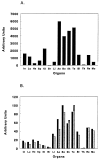cDNA cloning and expression of bovine procollagen I N-proteinase: a new member of the superfamily of zinc-metalloproteinases with binding sites for cells and other matrix components
- PMID: 9122202
- PMCID: PMC20095
- DOI: 10.1073/pnas.94.6.2374
cDNA cloning and expression of bovine procollagen I N-proteinase: a new member of the superfamily of zinc-metalloproteinases with binding sites for cells and other matrix components
Abstract
Procollagen N-proteinase (EC 3.4.24.14) cleaves the amino-propeptides in the processing of type I and type II procollagens to collagens. Deficiencies of the enzyme cause dermatosparaxis in cattle and sheep, and they cause type VIIC Ehlers-Danlos syndrome in humans, heritable disorders characterized by accumulation of pNcollagen and severe skin fragility. Amino acid sequences for the N-proteinase were used to obtain cDNAs from bovine skin. Three overlapping cDNAs had an ORF coding for a protein of 1205 residues. Mammalian cells stably transfected with a complete cDNA secreted an active recombinant enzyme that specifically cleaved type I procollagen. The protein contained zinc-binding sequences of the clan MB of metallopeptidases that includes procollagen C-proteinase/BMP-1. The protein also contained four repeats that are homologous to domains found in thrombospondins and in properdin and that can participate in complex intermolecular interactions such as activation of latent forms of transforming growth factor beta or the binding to sulfatides. Therefore, the enzyme may play a role in development that is independent of its role in collagen biosynthesis. This hypothesis was supported by the observation that in some tissues the levels of mRNA for the enzyme are disproportionately high relative to the apparent rate of collagen biosynthesis.
Figures






References
Publication types
MeSH terms
Substances
Associated data
- Actions
LinkOut - more resources
Full Text Sources
Other Literature Sources
Molecular Biology Databases
Miscellaneous

